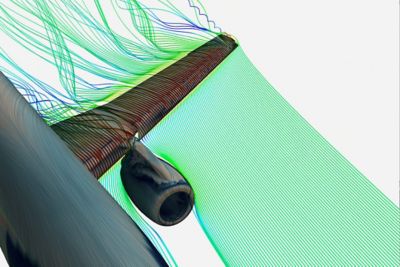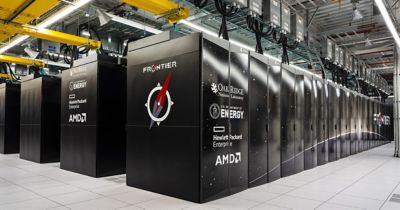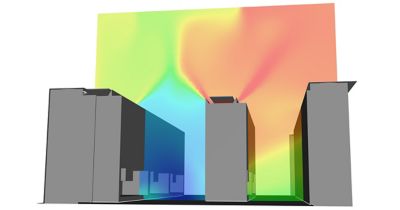-
United States -
United Kingdom -
India -
France -
Deutschland -
Italia -
日本 -
대한민국 -
中国 -
台灣
-
Ansys is committed to setting today's students up for success, by providing free simulation engineering software to students.
-
Ansys is committed to setting today's students up for success, by providing free simulation engineering software to students.
-
Ansys is committed to setting today's students up for success, by providing free simulation engineering software to students.
-
Contact Us -
Careers -
Students and Academic -
For United States and Canada
+1 844.462.6797

In an exciting announcement, Ansys has revealed record-breaking results from the largest commercial computational fluid dynamics (CFD) simulation ever conducted, using AMD Instinct MI250X GPUs. This milestone was made possible through a collaboration with Baker Hughes and Oak Ridge National Laboratory (ORNL) under the DDG CFD183 on the Frontier exascale supercomputer designed and delivered by Hewlett Packard Enterprise in 2022. Frontier is the world's first system capable of exceeding 1 quintillion (that is, 1 billion billion) calculations per second.
Scaling Ansys Fluent fluid simulation software to 1,024 GPUs, the team unlocked unprecedented insights into aerothermal physics and auxiliary combustion processes at extreme pressures. This achievement via commercial, general-purpose CFD simulation software represents a transformative leap forward for industries dependent on high-performance machinery, including energy production, propulsion systems, and power generation.
When comparing this to methods that utilize over 3,700 CPU cores, Baker Hughes and Ansys reduced the overall simulation run time from 38.5 hours to just 1.5 hours using 1,024 AMD Instinct MI250X GPUs.
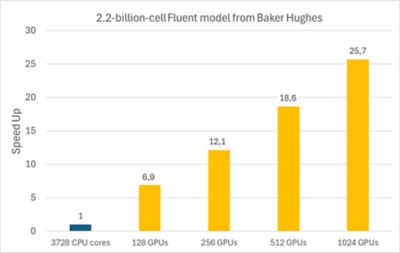
Why This Matters: Pioneering a New Era in Engineering Simulation
Exascale computing is a game-changer for the engineering and simulation landscape. By performing calculations over five times faster than today’s top supercomputers, systems like Frontier empower engineers and researchers to solve complex problems at an unprecedented scale and fidelity. The implications are profound: Industries can now design, test, and optimize products virtually, reducing the need for costly and time-intensive physical tests.
Traditional CFD methods often come with significant challenges, including lengthy development cycles and high costs for validating designs under extreme conditions. Leveraging exascale systems accelerates computation dramatically, enabling rapid design iterations that help companies reduce development timelines, enhance product performance, and achieve sustainability goals.
Pushing the Limits: Breakthrough Simulations at Unprecedented Scale
One of the key achievements of this collaboration was a 2.2-billion-cell axial turbine stator simulation conducted by Baker Hughes using Fluent software on the Frontier supercomputer. The simulation resolved critical turbulence structures and unsteady phenomena essential for optimizing gas turbine performance.
By scaling the simulation to 1,024 AMD Instinct MI250X GPUs on the Frontier exascale supercomputer, the team demonstrated the power of exascale computing to deliver unprecedented accuracy and speed in CFD simulations. The insights gained from these simulations are invaluable for designing high-performance machinery, predicting auxiliary combustion behavior, and developing more durable and sustainable energy systems.

By replacing costly and time-intensive experimental campaigns with digital simulations, companies can achieve rapid, accurate design iterations while dramatically reducing development costs and timelines.
Applications and Benefits of Exascale CFD Simulation
Baker Hughes’ use of Fluent software on the Frontier supercomputer marks a breakthrough for several key applications, including:
- Energy systems: Designing next-generation gas turbines and turbomachinery optimized for efficient energy conversion helps reduce carbon emissions.
- Performance predictions: High-fidelity simulations enhance the accuracy of performance assessments, emissions reduction strategies, and durability evaluations.
- Sustainability: Faster, more accurate simulations enable companies to innovate within broader design spaces, accelerating the deployment of advanced, environmentally friendly systems.
One significant advantage of leveraging GPUs on exascale systems is the creation of virtual test facilities. By replacing costly, time-intensive experimental campaigns with digital simulations, companies can achieve rapid, accurate design iterations while dramatically reducing development costs and timelines.
Transformative Impact on Customers
This technological breakthrough offers significant benefits to both end users and businesses:
End-user Benefits
- Enhanced reliability: Higher-performance machinery can be tailored for energy, aviation, and industrial applications.
- Lower emissions: Optimized designs contribute to a reduced environmental footprint.
- Improved efficiency: Faster innovation cycles lead to better, more durable products.
Business-level Benefits
- Faster time to market: Accelerated design cycles help companies stay competitive.
- Cost savings: Reduced reliance on physical testing lowers development costs.
- Broader design spaces: Companies can explore and optimize more design options with higher accuracy.
Before the introduction of Fluent GPU simulation technology, businesses faced numerous challenges that included limited insights from traditional CFD methods, lengthy development timelines, and high verification costs. By leveraging high-performance computing (HPC), companies can now overcome these hurdles, fostering innovation and competitiveness.
Empowering Small and Medium-sized Businesses (SMBs)
The advancements demonstrated on the Frontier exascale system also benefit SMBs operating on smaller GPU systems. The improved computational efficiency and scalability of the Fluent GPU solver enable these businesses to achieve high-fidelity simulations without needing access to exascale resources.
For example:
- Renewable energy startups: Optimize heat exchanger designs for energy recovery.
- Automotive Tier 2 suppliers: Simulate airflow in compact systems to improve vehicle efficiency.
These advancements bridge the gap between SMBs and large enterprises, empowering innovation across industries and democratizing access to cutting-edge simulation capabilities.
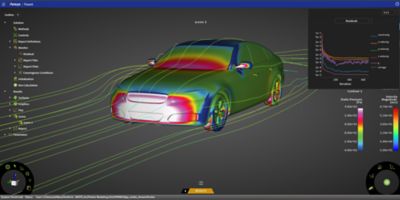
By pushing the boundaries of what's possible, the collaboration sets the stage for future advancements that will continue to break ground on equipment design and address some of the toughest challenges facing industries today.
Why This News Matters for Everyone
This achievement signals a significant leap in the ability to design and optimize the machines that power our world. From energy systems to aviation, these advancements have far-reaching implications in areas such as:
- Sustainability: The ability to reduce emissions and improve energy efficiency contributes to a greener, more sustainable future.
- Innovation acceleration: The increasing reliance on digital tools and simulations helps industries reduce costs, mitigate risks, and accelerate the pace of innovation.
- Technology partnerships: This collaboration showcases the power of partnerships among industry leaders, supercomputer centers (ORNL), hardware manufacturers (HPE and AMD), and software developers (Ansys) to drive progress that powers human advancements.
The successful scaling of Fluent software to 1,024 AMD Instinct MI250X GPUs on the Frontier supercomputer represents a transformative moment in CFD simulation. By pushing the boundaries of what's possible, this collaboration sets the stage for future advancements that will continue to break ground on equipment design and address some of the toughest challenges facing industries today.
Next Steps for Engineers
To further explore the groundbreaking achievements made possible by the Fluent GPU solver, download this white paper with detailed insights into the solution accuracy and performance improvements. You may also want to watch this webinar and learn about the latest Fluent 2025 R1 updates.
The Advantage Blog
The Ansys Advantage blog, featuring contributions from Ansys and other technology experts, keeps you updated on how Ansys simulation is powering innovation that drives human advancement.









